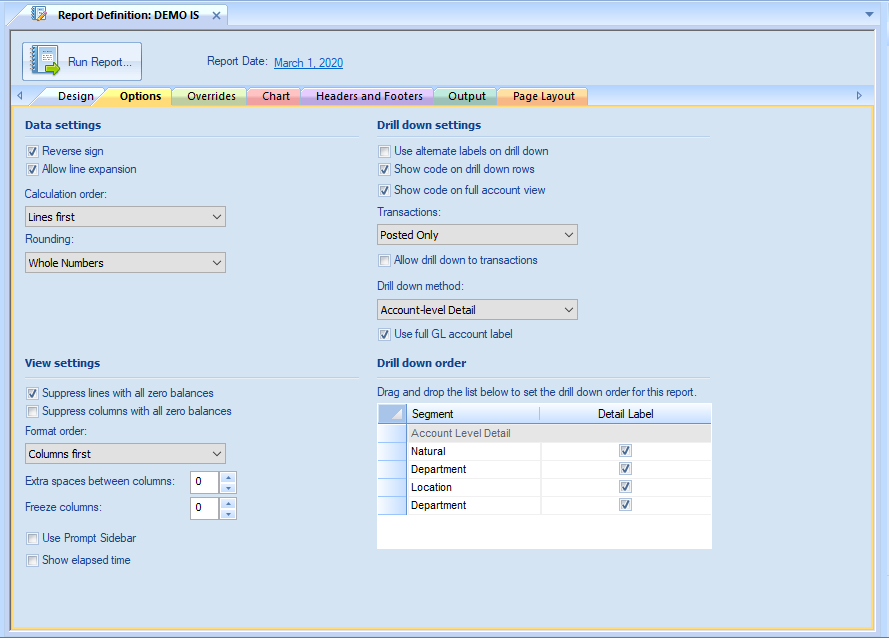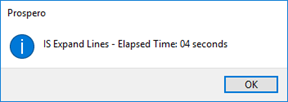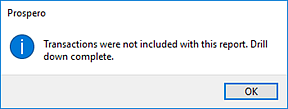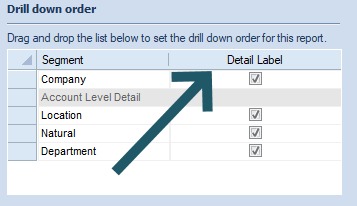
The Options tab of the Report Definition screen allows you to define the report’s data settings.

The available action and items on the Options tab include the following:
Data Settings
•Reverse sign – The Reverse sign checkbox option is used to indicate on your reports that you want signs reversed (Credit/Debit) for appropriate natural account items.
Import information to note regarding the Reverse Sign option:
1. If the user checks the Reverse sign checkbox, Prospero automatically reverses the sign based on the account type. (Users can override this easily using a '*-1' formula in the Line or Column Definition. For more information refer to Prospero Calculations.)
2. If the user does not check the Reverse sign checkbox, then the sign is reversed based on if the check box in the Line or Column Definition is selected to reverse the sign. This will occur no matter what the account type is.
•Allow line expansion – The Allow line expansion checkbox allows you to specify whether the lines will be expanded on a report (where that feature is used in a line definition.) When checked, if a line set uses the expand feature within it, the expanded rows will be generated with the report. If the checkbox is not checked, the expand setting within the line set is ignored. This setting is maintained when publishing reports, so if it was disabled on the generated report, it will be disabled on the published report. The default setting is to have this option enabled, or checked, for all new reports.
•Calculation Order – This option specifies the order for calculations to be performed on your report – either using columns or lines first. The default is “Lines first”.
•Rounding – This option specifies if rounding should occur to the whole number or the decimal precision defined for the Line or Column. Options are:
o No Rounding – Numbers will not be rounded and will show the number’s decimal precision.
o Whole Numbers – Numbers will be rounded and will show no decimal precision.
o Thousands – Numbers will show in the thousands and the number’s full decimal precision.
o Whole Thousands – Numbers will show in the thousands and will show no decimal precision.
o Millions – Numbers will show in the millions and the number’s full decimal precision.
o Whole Millions – Numbers will show in the millions and will show no decimal precision.
The default is “No Rounding”.
•Suppress lines with all zero balances – The Suppress lines with all zero balances checkbox allows you to specify whether to hide a given row based on the data in it.
•Suppress columns with all zero balances – The Suppress columns with all zero balances checkbox allows you to specify whether to hide a given column based on the data in it.
•Format Order – This option selects the order for any formatting to be applied to your report.
If “Columns first” is selected, the formatting applied to a Column Definition’s column will be applied to the report first and any Line Definition’s line formatting will be applied – and possibly overwrite the column’s formatting – thereafter. Conversely, the option “Lines first” will apply line and then any column formatting.
The default selection is “Columns first”.
•Extra space between columns – This option is a numeric value which indicates the extra space(s) between columns. You may enter a value between 0 and 99.
•Freeze columns – Sets the number of columns that will be frozen to the left of the screen (in other words, columns that will not scroll off the screen as you move to the right). You may freeze up to 9 columns. Note: hidden columns need to be counted when freezing columns.
•Use Prompt Side Bar - Allows users to change the prompt of a displayed report to look at a different level of the tree.
•Show elapsed time – Select this checkbox to show the amount of
time the report took to execute. You will receive a message once the report
execution completes. This option is not selected by default.

Drill down Settings
•Use alternate labels on drill down – Allows you to show alternate labels on drill down on reports. The Alternate label is defined on your segments’ worksheet(s) and allow you to show a label which is different from the segment item label. This setting will default to what is set in Options. For more on creating alternate labels see the section on the Segment Worksheet.
•Show code on drill down rows – Allows you to choose to show the code on the row when drilling down on report rows. The code value will be appended to the description. This option will default to what is set in Report Defaults Options.
•Show code on full account view – Allows you to choose to show the code on the rows on the Full Account Detail View. The code value will be appended to the description. This option will default to what is set in Report Defaults Options.
•Transactions – Allows you to define the type of transactions returned by the drill down method on your report:
o None – Returns no transactions on drill down.
o Posted only – Returns only posted transactions.
o Unposted only – Returns only unposted transactions
o Both – Returns both posted and unposted transactions.
The default is “Posted only”.
However, you must check the “Allow drill down to transactions” checkbox in order
for transactions to appear.
If you have selected “None”, the “Allow drill down to transactions” checkbox will be unavailable and unchecked. When you drill down to the posting level you will receive the following message:

•Allow drill down to transactions – When checked, this option allows report drill down to view the underlying transactions. Otherwise, drill down will not allow transactions to be shown on drill down.
If the “Allow drill down to transactions” checkbox is unchecked (or unavailable where Transactions = None), you will receive the following message when you reach the posting level:

This option is unchecked by default.
•Drill down Method – Allows you to define the drill down method your report will use:
o Reporting Tree Levels – Uses the standard Prospero Tree method for drill down which drills through each level of the tree associated to the report to the transaction level (if specified). This option is the Prospero default drill down method.
o Account-level Detail – Uses a drill down method which will only drill to the account-level detail. This is a non-subtotaling method which will only drill down to the report account lines.
o Mixed – This value indicates that the report will switch from Reporting Tree Levels to Account-level Detail at some point in the drill down order. Manually selecting this value has no real effect on the behavior of the report, as it will be defined by the drilldown order.
•Use full GL account label – This option will only be available when the drill down method selected is “Account-level Detail”. When checked, this indicates that the full account label from the GL will be reflected on the account -level detail. If this item is unchecked, account-level detail will reflect what has been previously brought in to the system through the integration. This setting will default to what is set in Report Defaults Options.
Note: This option is only available for GL integrations supporting this information.
Drill down order
•Drill down order – This section specifies the order of the segments for use in report drill down as well as if the label for the segment should be included.

You can drag-and-drop the Segments in the grid (up or down) to re-order the drill down on the reports. The gray row, titled “Account Level Detail” allows you to switch the report’s drill down method from Reporting Tree Levels to Account Level Detail after a certain point in the drill down order. Thus, you can first drill down to see your companies split out, then drill again to get the full account detail below a specific company.
If you require that your report options be set at the global-level (i.e. for all your Prospero reports), these settings can be changed and maintained in Report Defaults Options.